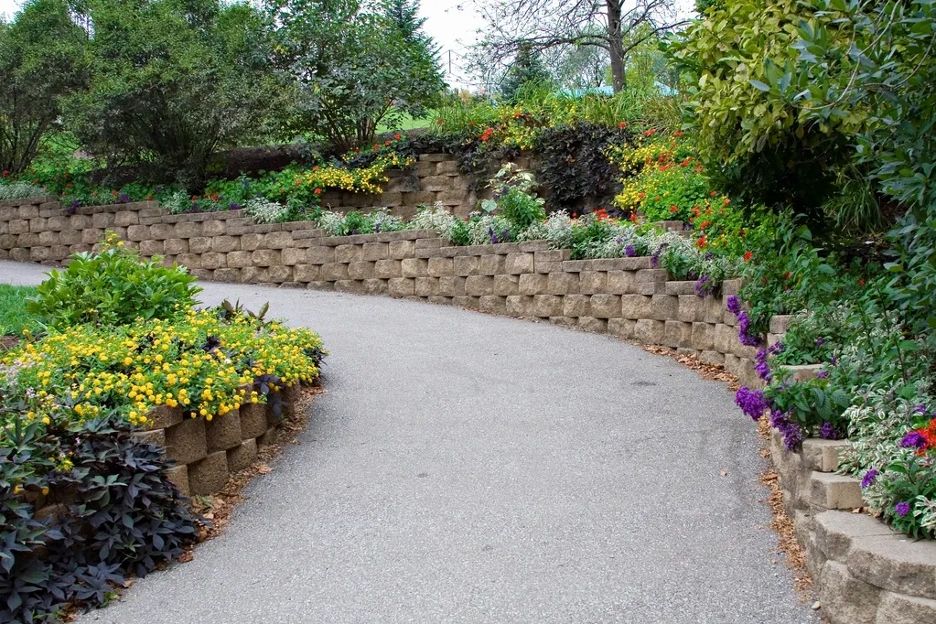Efficient irrigation options in Steep hill landscaping plants.
Efficient irrigation options in Steep hill landscaping plants.
Blog Article
Release Your Creativity With Distinct Styles in Steep Hill Landscaping for a Lovely Yard
Steep hillside landscaping provides both tests and opportunities for creative expression in outside layout. By employing ingenious terracing strategies and picking suitable native plants, one can not just maintain the soil but likewise boost the aesthetic appeal of a sloped yard.
Comprehending Steep Hillside Landscape Design
Exactly how does one efficiently navigate the challenges of steep hill landscape design? Steep hillsides existing certain difficulties, consisting of soil erosion, drainage issues, and ease of access concerns.
One of the key considerations in high hillside landscaping is dirt stability. Including ground cover plants, utilizing compost, or setting up retaining wall surfaces can considerably lower erosion while boosting the visual allure of the landscape.
Ease of access is an additional important aspect. Steep locations can hinder activity, making it vital to strategy pathways or actions that help with very easy navigation. Including these aspects thoughtfully can change a challenging incline into an attractive and functional outdoor room, improving both its functionality and aesthetic value. Eventually, recognizing the complexities of high hillside landscaping is crucial to attaining a harmonious and sustainable setting.
Cutting-edge Terracing Techniques
In the realm of steep hill landscaping, ingenious terracing strategies supply an effective service to handle difficult slopes while improving the landscape's appeal. By developing a series of stepped levels, these techniques not only stabilize soil however also create aesthetically enticing spaces that can be utilized for different purposes.

An additional ingenious strategy includes making use of modular systems, which allow for adaptability in design and convenience of setup. These pre-manufactured units can be quickly assembled to develop balconies that accommodate various inclines and dirt types.
In addition, increased beds can be incorporated right into terraced landscapes, providing possibilities for horticulture while enhancing the visual passion of the yard (Steep hill landscaping). By integrating these methods attentively, property owners can accomplish an unified equilibrium between performance and aesthetic appeals in their high hillside landscapes
Choosing the Right Plants
Selecting the right plants for high hillside landscapes is basic to developing a sustainable and aesthetically appealing environment. The unique challenges posed by sloped surfaces call for cautious consideration of plant attributes, including root systems, water retention, and development behaviors. Indigenous plants are commonly the additional reading ideal option, as they are adjusted to regional conditions, require much less maintenance, and offer habitat for regional wildlife.
When picking plants, focus on those with deep root systems, such as grasses and perennials, which can aid maintain the soil and prevent erosion. Ground covers like creeping thyme and sedum not just provide aesthetic allure however also offer to hold the dirt in place - Steep hill landscaping. Additionally, consider the water drainage patterns of the hill; plants that thrive in well-drained dirt will execute much better in these conditions
Including a range of elevations and appearances can boost aesthetic interest while ensuring that plants match each other in terms of light and water needs. Lastly, seasonal factors to consider must affect your selections-- picking plants that supply year-round rate of interest will certainly create a dynamic landscape that develops with the seasons. Thoughtful plant choice is vital to achieving both charm and performance in steep hill landscaping.
Creative Pathways and Qualities

Think about utilizing all-natural materials such as stone, crushed rock, or redeemed timber to create pathways that mix flawlessly with the landscape. Rounded walkways can soften the rough lines of steep inclines, while terraced styles can aid decrease disintegration and offer extra planting areas. Including steps made from wood or rock can promote movement via irregular terrain, guaranteeing safety while including aesthetic rate of interest.
In addition to paths, one-of-a-kind functions such as attractive boulders, sculptures, or water elements can serve as centerpieces, drawing the eye and adding personality to the landscape. Lighting along pathways not only improves safety yet additionally creates a magical setting during evenings, inviting exploration.
Moreover, incorporating seating areas within the landscape gives a room for leisure and reflection, permitting property owners to totally value the appeal of their surroundings. By thoughtfully integrating these aspects, steep hillside landscapes can come to be vivid, engaging atmospheres that offer both performance and creativity.
Upkeep Tips for Sloped Yards
Efficient maintenance is crucial for maintaining the charm and functionality of sloped backyards. As a result of their unique topography, these landscapes need specific techniques to ensure their durability and visual charm.
First and foremost, proper drain is critical. Routinely inspect rain gutters and downspouts to stop water from merging on the official statement slope, which can lead to disintegration. Executing a system of swales or French drains pipes can successfully reroute excess water.
Secondly, plant life plays an important function in stabilizing slopes. Choose ingrained plants that can hold the dirt in position, and regularly monitor their health. During droughts, make sure sufficient watering, however beware of overwatering, which can aggravate erosion.
Mulching is one more efficient maintenance strategy. Using natural mulch not only conserves moisture but also reduces weeds that could otherwise destabilize the soil.
Finally, routine evaluations for signs of disintegration or soil activity are crucial. If recognized early, remediation efforts such as re-planting or setting up keeping wall surfaces can prevent additional damages. By implementing these upkeep tips, home owners can take pleasure in a lively and resilient sloped lawn for several years ahead.
Conclusion
In conclusion, high hill landscaping offers a possibility to transform difficult terrains into visually captivating rooms. Through ingenious terracing strategies, the choice of appropriate indigenous plants, and the incorporation of creative pathways and functions, an unified and welcoming atmosphere can be accomplished. Furthermore, executing reliable upkeep strategies makes sure the longevity and sustainability of the landscape. Eventually, a properly designed high hillside landscape not only boosts aesthetic appeal but additionally promotes eco-friendly equilibrium and soil stability.
Report this page